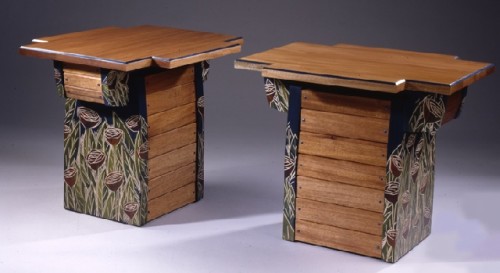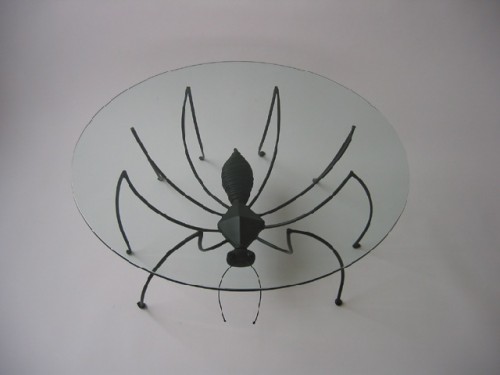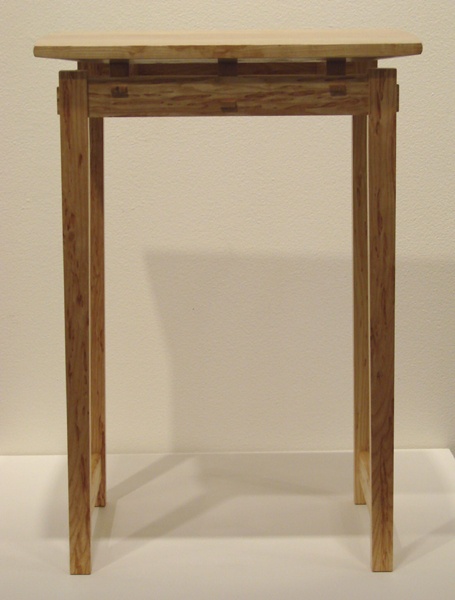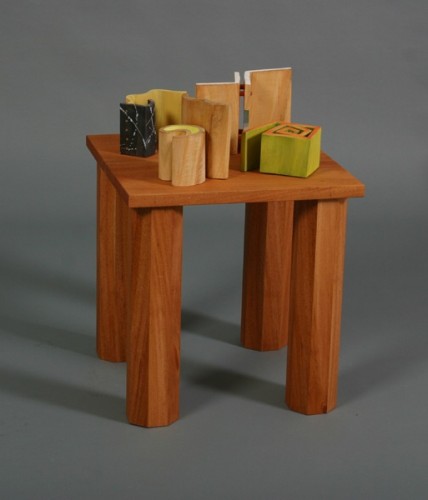Form and Function: Studio Furnituremakers at Gallery Naga
An Exhibition of Functional Art Joyously Crafted and Exhibited
By: Mark Favermann - Jun 07, 2007
Form and Function are generally the purview of pure design. Certainly beautiful design can transcend its form and function and be considered at times the highest level of visual art. Gallery Naga's Director Arthur Dion, over the years referred to by me as the "Godfather of Studio Furniture," has the subtle eye and sensitive demeanor as well as the connoisseur's patience to pick some of the best studio furniture being created today. And this is exactly what he did with Coffee, Hall, and End: Small Tables by Studio Furnituremakers, an exhibition shown May 4 to June 2 at his Newbury Street Gallery in Boston.Continuing Gallery Naga's exploration of the field of studio furniture, this is new work by a large group of furnituremakers. Most of the pieces were made specifically for this exhibition. Cleverly, all works were limited to no more than 36" in height, width, or depth. As a consequence of Arthur Dion's aesthetic inclinations, the show includes a selection of the finest small pieces by some of the best studio furnituremakers in this country now practicing their craft. Most are well known figures, represented in major museum collections. Some are young and emerging, and some are not so young, but beginning to enjoy even wider recognition.
Outstanding, even aesthetically uplifting shows like this take what could be common, mundane and even visually or tactilely boring and elevate everyday functional elements to pieces of at times exquisite attainment. Presented rather densely, this table exhibit was one beautiful surprise after another. Each artist made a quite personal aesthetic statement. Considering the large number of artists represented, fourteen (14) in all, the exhibit's sum is even greater than its individual parts. Yet, each part is a strongly crafted often highly personal visual statement of one or more pieces of furniture by each artist. Personally, I smiled when I walked into the gallery space.
I am always interested in how these studio furniture artists practice their aesthetic by uniquely interpreting both art history lessons and contemporary as well as historical modern design directions. This exhibition demonstrated this combination extremely well. Cubism, Pop Art, Primitive or Naive Art, Planar or Geometric driven art forms season a mix of Art Nouveau, Biedermier, Art Deco, Fifties Googlie aesthetic, Modernism, Constructivism and Bauhaus design elements with balance, elegance, scale, beautiful materials and significant function.
The smallest piece in the show is Garry Knox Bennett's Tabletop Table with Drawer. It was created at just under 12" high, constructed of Douglas fir, black bamboo, polished brass, pigmented epoxy, and beads. Like other work by Bennett, who is based in Oakland, California, its form and decoration is drawn on Asian sources. He was in the recent Inspired by China exhibition at the Peabody Essex Museum in Salem, Massachusetts. Bennett's work was the subject of a major retrospective in 2001 at the American Craft Museum (now the Museum of Arts and Design) in New York.
Hank Gilpin, another premiere figure in the field, who is based in Rhode Island, has worked principally on private commissions for over twenty years. He rarely shows in galleries. Dion explained that he had to wait several years to schedule Gilpin in a gallery show. His immaculately crafted six small tables, like much of his work, begin with the wood, not with a design. Then, he designs his pieces to display and express the character of the woods. Among the woods presented here are a highly figured box elder and a Tasmanian myrtle.
Rick Wrigley, who works in Provincetown, Massachusetts, is known for his strongly stated and exquisite joinery and exceptional marquetry. Here, he moves into entirely new terrain with an indoor/outdoor coffee table cast concrete, marble, and soapstone mosaic tile. However, the piece reflects the strength of Wrigley's personal aesthetic.
And Kim Kelzer, working in Freeland, Washington, perhaps the most nontraditional in a field known often for sly even irreverent wit, created a nightstand whose mahogany top is surrounded by a billowing pink skirt and stands on curvaceous legs, painted with black-and-white striped leggings, and balanced, in what might be point shoes actually standing on point. It suggests movement and animation. Clearly, this is a piece of furniture whimsy.
Tim Wells created the only piece that attached to the wall. His shelf-sized vanity, Spring, is
elegantly made from figured maple, leather, Lebanese cedar, and mahogany with a nickel-plated pull. The richness of texture and material is quite apparent here. The precision of the craftsmanship makes the quality of the piece visually sing. Likewise, James Schriber created the only set of table and chairs in the show. His dyed curly maple table and two chairs are beautiful silhouettes that speak strangely to Cubism and to Modernism as well as to comfort.
Todd Partridge's split-top tables work the edges of Modernism but somehow echo the Charles Eames and Isamu Noguchi Forty's and Fifty's aesthetic. The bleached and dyed ash, oak and white oak veneer pieces have a similar presence to those classic forms. Jere Osgood's Water Tables have an Amazonian or Congo tribal visual flow. Not surprisingly, they are made from Brazilian tulipwood and wenge, an African Rosewood.
Primitivism is extended to an even greater degree by the World master studio furniture maker, Judy Kensley McKie. As usual, her two beautifully constructed and ornamented tables incorporate rather tribally inspired animal bases. The cast bronze (limited edition of 12) Anteater Table makes me happy while the much less friendly giant steel and glass Spider Table (limited edition of eight) makes me cringe a bit. Even so, whatever McKie creates is masterful and often a masterpiece. She is a national treasure.
Jenna Goldberg's two painted and carved basswood and mahogany tables evoke an Arts and crafts and art Nouveau discourse while being strongly contemporary. While Christine Enos is
working with maple and bamboo, she uses lacquer, milk paint and acrylic paint to visually express an at once classical but yet of today Asian feeling in her work. John Dunnigan's cast bronze and pate of glass (cast pate de verre) table also seems rather classically Chinese or Japanese wrought contemporary, while his lacewood table seems like a latter day descendent of Biedermier Style.
John Eric Byers' Table #1 and Table #2 are created from mahogany and covered by milk paint and lacquer. Strangely the pieces have a Wiener Werkstatte sensibility. This was the geometric turn that Art nouveau took in Vienna at the turn of the last century and was so influential to everything that followed. Dale Broholm's ebonized cork Cocktail Table looks surprisingly like a monster egg holder. There is whimsy here and quite a bit of skill to make this piece look like it was so simple. The profile of this piece is strong and unique and looks like nothing else is related to it in the exhibition.
Previously, I said that when I entered Gallery Naga to see the exhibit, I smiled. I was very happy thinking of the show when I left as well. On an encouraging note, this was a very successful exhibit for the artists and the gallery in terms of sales. The reasons for this may be many. However, Studio Furniture is very appealing and even functional. The sizes of these pieces made them relatively affordable for a range of collectors both sophisticated and existing as well as learning and starting out. And many of the pieces were done in editions and could be produced in series by the artists. In fact, those who were unfortunate enough to miss this superb show can order many of the pieces even after the show. In other words, this is an exhibit that can keep on giving. Isn't that the test of our best art?











